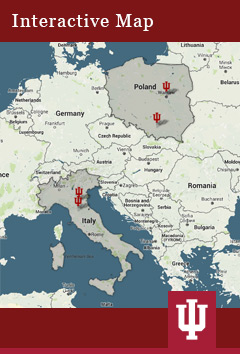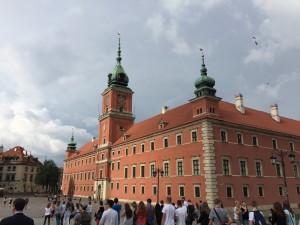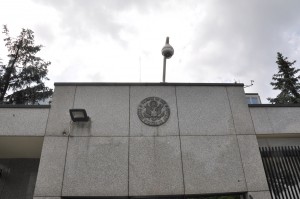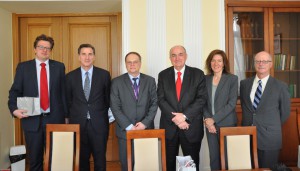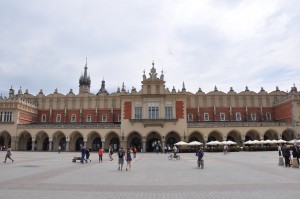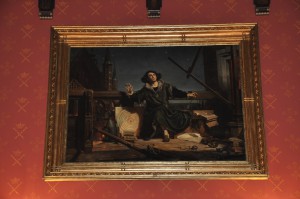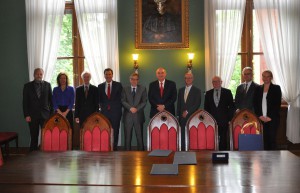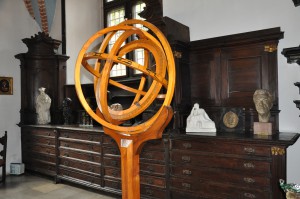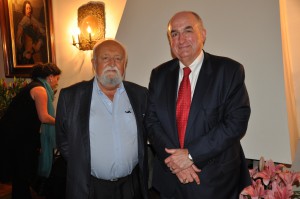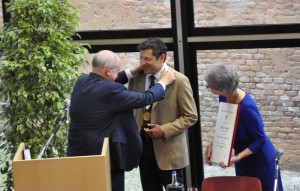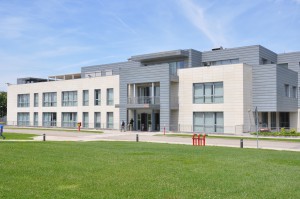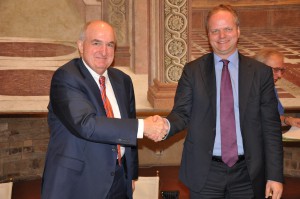New beginnings and the conclusion of a historic week in Poland and Italy
Four of the world’s most culturally vibrant cities. Three of the oldest and most highly esteemed universities. Two historically dynamic countries. One unforgettable week.
No matter how you calculate it, members of the IU delegation will carry countless memories back to Bloomington after what has been a highly productive, purposeful and inspiring weeklong trip through Italy and Poland.
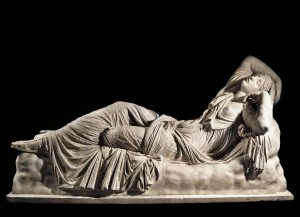
Arianna dormiente, a classical Roman sculpture, is one of the works from the Uffizi Gallery in Florence, Italy, that will be digitized in 3-D.
It was a week that started in sensational fashion — with the announcement of an unprecedented agreement with the Uffizi Gallery in Florence, Italy, that will result in the 3-D digitization of all 1,200 of the Greek and Roman sculptures housed at one of the world’s most renowned museums. It’s almost impossible to overstate the importance of this project and, specifically, the opportunities it will provide IU students and faculty to engage with an irreplaceable collection of art.
Just a few days later, IU delegation members experienced, first-hand, the historic bond between Bloomington and the ancient city of Bologna, where one of IU’s most successful study abroad programs has changed lives and created lifetime linkages between its hundreds of proud alumni. Many of those alumni returned to Bologna for a momentous 50th anniversary reunion celebration.
From beautiful Bologna, with its magnificent Baroque and Renaissance architecture, cultural splendor and, yes, mouth-watering cuisine (oh, how soon we won’t forget the pasta!), it was on to the equally breathtaking Krakow, one of Poland’s most important academic, artistic and cultural centers. Though 24 hours afforded little time to fully appreciate this spectacular city, IU found time to renew its relationship with Jagiellonian University, where such famous scholarly figures as Copernicus and Karol Wojtyla, later Pope John Paul II, received their academic training.
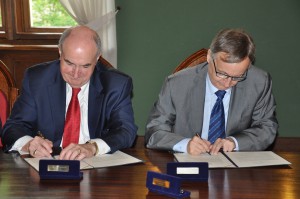
IU President Michael A. McRobbie, left, and Wojciech Nowak, president of Jagiellonian University, renew a partnership agreement between their respective institutions.
The partnership between IU and Jagiellonian University calls for an expansion in the number of faculty and graduate student exchanges that have taken place between the two universities for three decades now. Not to be forgotten was IU’s harmonious meeting with Maestro Krzysztof Penderecki, Poland’s greatest living composer, and his most gracious wife, Elzbieta. Maestro and Mrs. Penderecki’s anticipated arrival in Bloomington in early 2017 to receive an honorary doctorate from the university will almost certainly be a major highlight of the next academic year at IU.
Finally in Warsaw, a city thoroughly decimated and relegated to rubble during World War II, delegation members witnessed the remarkable resilience and rejuvenation of a country that has endured centuries of challenge and almost unfathomable tragedy. Today, though, Warsaw has positioned itself — through a determined effort to enhance its economy, education and democracy — as a central contributor to the success of the 21st-century European community.
Beyond the incredible sights, smells and sounds they experienced, however, members of the delegation could take great pride in knowing that the seeds sown here in Europe would soon benefit IU students and faculty back home. While we raced across Krakow and Warsaw for a series of meetings, a team of students and other scholars, led by IU informatics professor Bernie Frischer, had already begun work on the 3-D scans of some of the major sculptures in the Uffizi Gallery in Florence. Indeed, by renewing its most successful and productive partnerships and initiating several exciting new collaborations, IU has ensured greater opportunities for its students to broaden their knowledge and understanding of other cultures. What’s more, it’s helped to ensure that its students and faculty work with the most talented scholars and in the most intellectually inspiring places around the world.
Reflection and remembrance
Members of the IU delegation had the opportunity to tour one such location this morning in Warsaw. The POLIN Museum of the History of Polish Jews, which first opened in spring 2013, is truly a spectacular site. Housed in a post-modern, rectangular structure built from concrete, copper and glass, and designed by master Finnish architect Rainer Mahlamäki, it stands in what was once the heart of Jewish Warsaw — an area that the Nazi government turned into the Warsaw Ghetto during World War II. The Warsaw Ghetto was the largest of all of the Jewish ghettos in Nazi-occupied Europe during World War II. This symbolic setting — along with the museum’s proximity to the Monument to the Ghetto Heroes, which commemorates those individuals who lost their lives in the Warsaw Ghetto uprising — helps to serve the museum’s mission, which director Dariusz Stola neatly defines as “reflection and remembrance.”
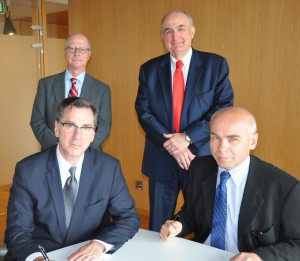
IU School of Global and International Studies Dean Lee Feinstein, left, and Dariusz Stola, director of the POLIN Museum of the History of Polish Jews, sign an internship agreement between IU and the museum. In back from left are IU Vice President for International Affairs David Zaret and President McRobbie.
The museum, which was named European Museum of the Year this year, seeks to recall and preserve the memory of the history of Polish Jews, contributing to greater mutual understanding and respect among Poles and Jews as well as other societies of Europe and the world. Secondarily, it aims to create a modern, multifunctional museum that provides an educational and cultural center, along with a platform for social dialogue.
The POLIN Museum, a six-story building made up of eight galleries, traces the story of Polish Jews, from the beginnings of Jewish settlement in Poland and rise of Jewish culture during several ensuring centuries to the horrors of the Holocaust. Through the use of photographs, artifacts, first-person accounts and interactive multimedia, the museum’s “Core Exhibition” leads visitors on a journey through 1,000 years of Jews in Poland, including what led them to settle in Poland, why they stayed and how the country eventually became home to one of the largest Jewish communities in the world — there were 3.3 million Jews in Poland before the Holocaust.
The Core Exhibition is directed by a wonderful IU alumna, Barbara Kirshenblatt-Gimblett. She worked with a team of more than 120 curators, scholars and designers on the exhibition, which opened to considerable fanfare less than two years ago. (A personal aside: I will never cease to marvel at the IU connections in important educational, political and cultural organizations all around the world!)
On Wednesday morning, Kirshenblatt-Gimblett kindly led IU President Michael A. McRobbie and his colleagues through a memorable tour of the exhibition’s galleries, each of which presents a different chapter of Polish Jews that enables visitors to come into intimate contact with those who wrote that story.
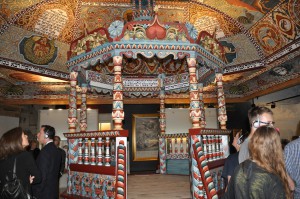
One of the standout piece in the POLIN Museum’s Core Exhibition is a wooden synagogue, originally built in the mid-17th century and painstakingly reconstructed by almost 400 volunteers from Poland and abroad.
Words truly can’t describe what it feels to walk through the Core Exhibition. Simply put, it’s an incredibly moving experience. Particularly memorable stopping points were a large map of all of the hundreds of cities, small towns and villages across the country where Polish Jews lived and worked; a wooden synagogue, originally built in the mid-17th century and painstakingly reconstructed by almost 400 volunteers from Poland and abroad; a railway station symbolizing the industrial revolution in the mid-19th century that led to a mass migration of more Jews to Poland and the growth of the country’s metropolises; and the gray, somber room representing the horrors and atrocities of the Holocaust, from which barely 300,000 Jews survived, most of them in the Soviet Union.
After the tour, Stola met members of the IU delegation, including McRobbie, Vice President for International Affairs David Zaret and Lee A. Feinstein, former U.S. ambassador to Poland and founding dean of the IU School of Global and International Studies, who has played a central role in the museum’s development. Feinstein currently sits on the North American Council of the museum; while serving as U.S. ambassador in 2011, he escorted President Barack Obama to the construction site of the museum. The discussions among the IU and museum leadership focused on linking the museum with various academic units at IU and leveraging the university’s considerable expertise — including in Jewish studies, Polish studies, Russian and East European area studies, foreign language instruction, arts administration and museology — to uphold the museum’s mission of supporting research and scholarly exchange on the history and culture of Polish Jews.

From left: IU Vice President for International Affairs David Zaret, President McRobbie and Marian Turski, chairman of the POLIN Museum Council. Turski is a survivor of the Auschwitz concentration camp who went on to a distinguished career in Poland as a journalist and Jewish activist.
As a major first step in what promises to be a terrific collaboration, McRobbie and Stola signed a new partnership agreement Wednesday between IU and the POLIN Museum that will create opportunities for talented IU undergraduate students to intern at the museum during the summer. Conversations about further IU and POLIN connections then continued over a most memorable lunch at the museum, including Stola, Kirshenblatt-Gimblett and two members of the POLIN Museum Council. The council representatives included two incredibly remarkable men: chairman Marian Turski, who survived the Auschwitz concentration camp and went on to a distinguished career in Poland as a journalist and Jewish activist, and professor, researcher and diplomat Adam Rotfeld, also a Holocaust survivor, who served as minister of foreign affairs for Poland and today is an authority on the political and legal structures of the security system in Europe and human rights.
In our short but memorable time together, members of the IU delegation learned that Turski marched with the Rev. Martin Luther King Jr. and — as yet another illustration of IU’s deeply rooted ties to Poland — spent quality time in Bloomington during the mid-1960s conducting research in the libraries of the School of Journalism and elsewhere around campus.
A historic and meaningful partnership
Despite the often breakneck pace of the delegation’s travels through Florence, Bologna, Krakow and Warsaw, we nevertheless were afforded time to consider IU’s powerful international ties and just how prescient past presidents, senior leaders and faculty were in pursuing opportunities for global engagement, no matter how complex the country or challenging the circumstance.
At the University of Warsaw, it was nearly impossible not to think back to 40 years ago and wonder what was going through the minds of the IU and University of Warsaw faculty who, at the height of the Cold War, joined together for scholarly collaboration at a time when such activities were few and far between.
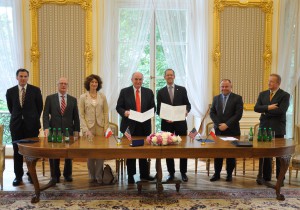
President McRobbie and Marcin Palys, president of the University of Warsaw, proudly display signed agreements renewing the 40-year partnership between their respective institutions.
Despite a lack of trust and misunderstanding that marked relations between the U.S. and the Soviet Union, visionary leaders at both institutions agreed in 1976 to engage in a partnership that led to the establishment of two area studies centers that have experienced great success over the past four decades: the American Studies Center here in Warsaw and the Polish Studies Center back in Bloomington.
To listen to members of the current University of Warsaw faculty talk is to understand how meaningful this partnership has been, both now and then. At a time when Polish scholars felt isolated from the rest of the world, in the 1970s and 1980s, IU’s connection with the American Studies Center in Warsaw was truly the first of its kind with a partner institution in east-central Europe, and the center’s library served as the only open access library east of Berlin. Many of those who used the center and who visited or attended IU graduated to major roles in academia, government and public policy, both before and after the fall of communism in 1989.
“I don’t know if people in Indiana have any idea how much [the partnership] meant to our country’s scholars,” professor Bohdan Szklarski, director of the American Studies Center at the University of Warsaw, said Wednesday afternoon. “Indiana University symbolized for Polish visitors what America stood for: freedom, opportunity and creativity. We returned to Poland with new ideas and open minds.”
In turn, the University of Warsaw has contributed greatly to the scholarly and intellectual life at IU. Through the partnership, dozens of IU faculty and graduate students have studied and taught in Poland, and an equal of number of scholars from the University of Warsaw have come to IU’s Bloomington campus.
In recent years, IU has also organized several important academic conferences and symposia and welcomed numerous influential Polish dignitaries — including former Polish president and Nobel Peace Prize recipient Lech Walesa and the late Nobel Laureate and celebrated Polish poet and novelist Czeslaw Milosz.
New beginnings
On Wednesday, McRobbie joined his University of Warsaw counterpart, President Marcin Palys, in signing a renewal of one of IU’s most successful international partnerships and meeting to discuss ways to fortify and further the collaboration for another 40 years. Accompanying McRobbie at the signing was Dean Feinstein, who forged a strong relationship with the University of Warsaw during his three years as ambassador to Poland, from 2009 to 2012, and Vice President Zaret, whose office oversees the central institutional partnership.
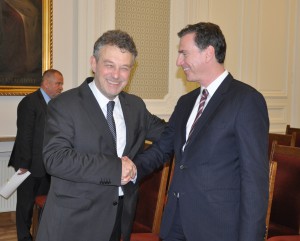
Polish Ambassador to the U.S. Ryszard Schnepf shares a laugh with Lee Feinstein, former U.S. Ambassador to Poland and founding dean of the IU School of Global and International Studies.
At the meetings, officials from both IU and UW agreed that the time is ripe for expanding student and faculty exchanges and research collaborations between the universities, and finding opportunities to extend the collaboration across various academic areas where the two universities share considerable strengths: the arts and humanities, area studies, business, language instruction, law, media and more.
Following the signing and meetings, McRobbie led IU’s participation in a special 40th anniversary celebration of the partnership, which featured several distinguished guests, including Polish Ambassador to the U.S. Ryszard Schnepf and past and present UW leaders.
To commemorate the occasion, the two universities launched the Krzysztof Michałek Memorial Lecture in American Studies, named for one of the former directors of the American Studies Center in Warsaw who also spent two years at IU as associate director of the Polish Studies Center. John Bodnar, IU Distinguished and Chancellor’s Professor of History, delivered the inaugural lecture at the celebration on the topic of war and memory.
On behalf of the entire IU delegation, McRobbie expressed our pride in reaffirming IU’s continuing and deep interest in Poland, a country of amazing resilience.
“That Poland has recovered and rebounded so successfully and dynamically after many decades of tragedy and horror to be once again one of the leading countries of Europe is a testimony to the extraordinary resilience and moral courage of the Polish people,” he said.
Fittingly for a celebration of 40 years of collaboration, Wednesday’s ceremony concluded with two major exchanges.

McRobbie presents the Thomas Hart Benton Medallion to Marcin Palys, president of the University of Warsaw, in recognition of the landmark and successful partnership between the two universities.
Following his speech, McRobbie presented the Thomas Hart Benton Mural Medallion to UW President Palys, in recognition of the landmark and successful partnership between the two universities. Palys later bestowed upon McRobbie UW’s prestigious Bicentenary Medal of the University, also in recognition of the 40 years of active partnership between the two institutions.
McRobbie focused his closing remarks on the future of the IU-UW collaboration. “As we celebrate the 40th anniversary of our partnership, and as the American Studies Center and the Polish Studies Center enter the next phase of their operation, I am confident that the partnership between our institutions will continue to thrive,” he said.
In the days and weeks that follow this memorable and inspiring trip, there will surely be many moments for members of the IU delegation to reflect upon the historic places and heralded programs we visited this week. Our POLIN Museum-based alum Barbara Kirshenblatt-Gimblett may have said it best, as she sought to maneuver us through 1,000 years of history in an hour — which was all the time we had to tour a museum in which one could spend days. There are three types of people she typically takes on tours, she said, “skimmers, swimmers and divers. … This is clearly a group of divers.”
Many decades ago, IU chose to take a deep dive into the most dynamic and historic parts of Europe, and I can proudly report that the results of that engagement — here in Poland and also in Italy — have made a remarkable difference in the lives of our students, our faculty and our alumni and friends in Indiana and all over the world.
Do widzenia, arrivederci and goodbye, and thanks to everyone for reading!
Tags: American Studies Center, Barbara Kirshenblatt-Gimblett, Bernie Frischer, Bologna, David Zaret, Florence, Indiana Alumni Association, Italy, IU Polish Studies Center, Jagiellonian University, John Bodnar, Krakow, Lee A. Feinstein, Marian Turski, Michael A. McRobbie, Poland, POLIN Museum of the History of Polish Jews, Ryszard Schnepf, Thomas Hart Benton Medallion, Uffizi Gallery, University of Bologna, University of Warsaw, Warsaw
Resilience and rejuvenation in Poland
Walking the streets of Warsaw, it’s impossible not to be inspired by the resilience of a city that, throughout its 700-year history, has endured an almost unthinkable amount of turbulence and tragedy.
Sadly, unlike Krakow to the southeast, Warsaw — Poland’s capital and largest city — retains next to none of its original buildings, due to the horrible events of World War II. After the German invasion of Poland in 1939, the Nazis forced the city’s entire Jewish population, which included around 400,000 thousand people, into what would be known as the Warsaw Ghetto. From there, at least 254,000 of the area residents were sent to a concentration camp over the course of just two months in summer of 1942.
Not long after creating the sealed-off area, in 1944, with the Russian Red Army nearing Warsaw, Adolf Hitler ordered the entire city to be razed to the ground, reducing Warsaw to a sea of rubble. The Nazi reign of terror resulted in the destruction of 85 percent of the city, including the historic “Old Town” and almost all of the city’s once-proud government edifices, castles, churches and monuments.
For more than four decades following the war, a communist regime, set up by the conquering Soviet Union, would rule Warsaw. During this time, the new government erected a number of buildings that reflected the monolithic and minimalist architectural style of the rest of the communist states of Central and Eastern Europe, also known as the Eastern or Soviet Bloc.
Ultimately — some might say miraculously — neither the Nazis nor the Soviet communists could contain the proud spirit of the Polish people of Warsaw, who over the last half century have meticulously reconstructed much of their old city. The city currently features many prominent buildings that reflect a variety of architectural styles. The so-called Stalinist empire style, or “socialist classicism,” still permeates large parts of Warsaw, but it is complemented by some magnificent architecture, a combination of modern and old world, that reflects a remarkably cosmopolitan city. Indeed, a five-year construction campaign resulted in the successful restoration — in the Baroque and Renaissance style — of the marketplace, churches, palaces and town homes of Krakow’s Old Town, which has once again assumed its proper place as the heart of the city.
Today’s Warsaw reflects the rebirth and rejuvenation of Poland, which has literally risen from the ashes to become one of 21st century Europe’s most vitally important countries.
Poland’s ascent in stature is clearly testament to the extraordinary determination and will of the Polish people, who have helped lead the nation to a most interesting crossroads. Indeed, today’s Poland finds itself in a prominent leadership position within the European community, and the country is suddenly being challenged to ensure that the positive results of its dramatic transformation are felt more nationally, including in its most remote villages and small towns. Furthermore, the country is now being pushed to share its extraordinary “Polish experience” — one of unique economic and democratic success — with the other countries of Central and Eastern Europe.
Expanding educational opportunity
On Tuesday morning, members of the IU delegation met in downtown Warsaw with the leaders of the Polish-American Freedom Foundation, including its president and CEO Jerzy Kozminski, former Polish ambassador to the U.S. Last year, the foundation celebrated 15 years of working to strengthen Poland’s civil society, democracy and market economy, in large part by equalizing and expanding opportunities for educational and social development.
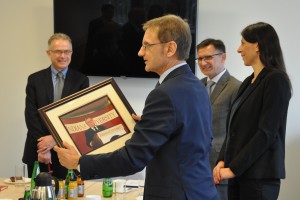
Polish-American Freedom Foundation President and CEO Jerzy Kozminski receives a framed picture of when former Polish President Lech Walesa visited IU.
Since its founding, the Polish-American Freedom Foundation has launched a number of successful initiatives focused on education and community development in rural areas and small towns in Poland. They include, among other programs, training and grant competitions aimed at improving the quality of English-language teaching; new “bridge” scholarships for talented high-school graduates; opportunities for student volunteerism; leadership and skill-development training; support systems for Polish NGOs and civic initiatives; and civic and legal counseling.
Looking beyond Poland, the foundation has established a scholarship program for young leaders from across Eastern Europe, as well as from South and Central Asia, to perform their post-graduate studies at Polish universities and participate in internships in Polish companies. The foundation is also engaged in establishing grants, training opportunities and study tours that help illustrate the realities of Poland’s growth and major role within the European Union to foreign students and scholars.
Today’s more than two-hour meeting revealed several areas in which IU and the Polish-American Freedom Foundation might potentially collaborate, as IU pursues a global strategy centered on, as neatly outlined today by IU President Michael A. McRobbie, raising IU students’ knowledge and understanding of other cultures through expanded overseas study opportunities; diversifying IU’s campuses through the addition of more international students, especially those from countries with less of a tradition of sending students to the U.S.; building collaborative relationships between IU faculty and their peers in top institutions around the world; and furthering IU’s longstanding tradition of academic and government institution-building.
Former U.S. Ambassador to Poland Lee Feinstein, the founding dean of IU’s School of Global and International Studies, and IU Vice President for International Affairs David Zaret both spoke openly about how proud IU has been of its historic relationship with Poland, which dates back 40 years and the formative role IU played in the creation of the American Studies Center at the University of Warsaw. (IU will participate in a special 40th anniversary celebration at the University of Warsaw on Wednesday afternoon.) Feinstein and Zaret also illuminated the university’s strengths in leadership training, public management and administration, area studies, foreign language instruction, business, law and other academic fields seemingly well aligned with the Polish-American Freedom Foundation’s priorities here in Poland.
Additionally, Hannah Buxbaum and Andrea Adam Moore, academic and gateway directors, respectively, of the new IU Europe Gateway office in Berlin, shared how the new office, which opened last fall, will support activities and initiatives for IU faculty to deepen ties with key institutional partners in Poland and across Europe.
The meeting concluded on a symbolic note of sorts — with McRobbie presenting Kozminski with a framed picture of former Polish President Lech Walesa taken in 1998, when the renowned solidarity hero and Nobel Peace Prize recipient made a celebrated visit to IU Bloomington, just one of the many chapters in IU’s storied history with this great country.
A commitment to the future
From the Polish-American Freedom Foundation, the delegation made a stop at former Ambassador Feinstein’s old stomping grounds here in Warsaw to meet at the U.S. Embassy with current U.S. Ambassador to Poland Paul W. Jones.
The meeting with Ambassador Jones, who assumed his post in Poland in September, offered delegation members another opportunity to highlight IU’s historic engagement in Poland and enthusiasm for re-energizing its partnerships here. IU took the first step in that process Monday when it renewed its cooperative agreement with Jagiellonian University in Krakow, one of the world’s oldest and most highly respected universities.
For his part, Jones was gracious in reminiscing about shared embassy experiences and challenges with his predecessor, while simultaneously offering several interesting insights into the state of higher education here in Poland. Indeed, it was especially generous of the ambassador to host the Hoosier delegation today, considering the major events coming up on the embassy’s horizon — in early July, his office will play a central role in organizing the historic Warsaw Summit, a meeting of all of the heads of state of NATO at Warsaw’s 58,000-seat National Stadium.
In particular, when it comes to Poland, IU has considerable interest in adjusting its focus toward issues concerning areas important to modern Poland and its future development.
“As proud as we are in our past relationship with Poland, we don’t want to rest on the past. We are really interested in moving our collaborations forward,” Feinstein told professor Leszek Sirko during the delegation’s final meeting late Tuesday afternoon. Sirko serves as Poland’s under-secretary of state in the Ministry of Science and Higher Education, and he is currently championing an effort to expand Poland’s research profile, in part by exploring possible collaborative activities with the best and most international research universities around the world. He was especially attracted to IU, which, he said, had managed the rare feat of partnering with Polish universities when such Cold War collaborations were the exception, not the norm, and he complemented IU for seeking to further its connections to Poland at a critical time in the country’s history.
(Coincidentally, and further proving that IU truly is everywhere, one of Sirko’s colleagues who attended today’s meeting had his own personal connection to IU. While pursuing his Ph.D. several years ago, Tomasz Kollat, chief expert of the Ministry’s Department of International Cooperation, spent time in Bloomington conducting research at the Department of Central Eurasian Studies.)
As the conversation continued, Sirko also became increasingly intrigued by IU’s new Grand Challenges research program to address complex, large-scale problems facing society and the university’s recent successes in advancing STEM education, two areas in which he is extremely passionate.
Finally, Henryka Bochniarz, one of Poland’s most prominent business leaders and feminists, joined the delegation for a working dinner to discuss trends in higher education and related issues. Among those also attending the dinner were a former minister of higher education and member of the European Parliament, the dean of Kozminski University, an internationally ranked private university in Warsaw, and other senior leaders in education and the private sector.
Interestingly, but not at all surprisingly, a singular theme surfaced at each of the IU delegation’s meetings today: Poland is extremely passionate about internationalizing its educational programs, and it sees in IU a strong and successful partner firmly committed to this dynamic country’s bright future.
Tags: Andrea Adam Moore, David Zaret, Hannah Buxbaum, IU Europe Gateway, IU Maurer School of Law, IU School of Global and International Studies, Jerzy Kozminski, Lee A. Feinstein, Leszek Sirko, Michael A. McRobbie, PAFF, Paul W. Jones, Poland, Polish-American Freedom Foundation, Tomasz Kollat, U.S. Ambassador, University of Warsaw, Warsaw, Warsaw architecture
A celebration of history, education and culture in Krakow
After a whirlwind four days in Florence and Bologna, members of the IU delegation were almost instantly re-energized when they touched down in Krakow, Poland, and commenced the second leg of this one-week, two-nation trip.
Krakow is nothing short of breathtaking. One of Poland’s oldest cities, dating back to the seventh century, it’s often cited as one of Europe’s most beautiful cities. Krakow’s stunning skyline reflects a combination of Gothic, Renaissance and Baroque architecture. As we stood in the middle of the city’s Rynek Glowny, the main market square of old-town Krakow and one of the largest medieval town squares in Europe, it was impossible not to be captivated by the centuries-old structures surrounding us.
I, for one, frequently found myself playing catch-up with the rest of the delegation, paralyzed by both the majesty of Cloth Hall, the square’s dominant rectangular icon, and the beauty of St. Mary’s Basilica — a Brick Gothic church built in the 13th century and famous for its Veit Stoss altarpiece, the largest Gothic altarpiece in the world. [Another personal aside — part of my heritage is Polish, with my great-grandparents having once inhabited a small town in southeastern Poland not far from Krakow. Sadly, I know but a few Polish words, but it’s already been wonderful to learn a little more about my family’s cultural makeup.]
Situated on the banks of the Vistula River, the longest and largest river in Poland, Krakow features a rich and unusual history. In its earliest centuries (1038-1569), it served as the capital of the Crown of the Kingdom of Poland. Many years later, after Germany’s invasion of Poland in 1939, it was proclaimed the capital of Germany’s General Government, effectively preserving the architectural core of the city when most of Poland’s major cities, including Warsaw, were utterly devastated. By the end of the war, in 1945, when the Russian army removed the Nazis from Krakow with little resistance from the fleeing enemy, the city’s structures were again spared.
Today, Krakow, with a population of about 800,000 people, is considered one of Poland’s most important academic, artistic and cultural centers and an economically dynamic hub of Poland and Eastern Europe.
Krakow: A center of the academic universe
Krakow is also home to Jagiellonian University, one of the oldest and most respected universities in the world. Founded by King Casimir III the Great in 1364, it grew to prominence in the Middle Ages and the Renaissance, and its educational offerings, particularly those in astronomy, law, mathematics, drew many of the best scholars from across Europe. One of the most notable of those scholars was Nicolaus Copernicus, the legendary Renaissance mathematician and astronomer who developed the model of the university placing the Sun, rather than the Earth, at the center of the universe.
In 1918, after the end of World War I, Poland regained its independence after being ruled for many years by its neighboring countries, thus accelerating the development of Jagiellonian University. More than 4,000 young people came to the university to study in this post-war period, but that growth came to a halt with the outbreak of World War II and Nazi occupancy of Poland. On Nov. 6, 1939, the Nazis arrested nearly 200 members of the university faculty and sent them to a concentration camp. In response, a secret school, involving about 800 students, began in 1942. Karol Wojtyla, later Pope John Paul II, was one of these students.
Following the war’s end, the university was forced to respond to a new communist reality in Poland, which resulted in several decades of student protests against the ruling regime.
Since the collapse of communism in Eastern Europe in 1989, Jagiellonian University has undergone a dramatic rebirth and revival. Over the last 25 years, the university has established new schools in biochemistry, biophysics and biotechnology, and in international and political studies. Today, the university features 15 schools and three medical schools that serve approximately 50,000 students, slightly more than IU’s Bloomington campus.
On this day, the university provided a most majestic setting for a productive meeting between members of the IU delegation, led by President Michael A. McRobbie, who is making his first visit to Poland, and top administrators from Jagiellonian University, including President Wojciech Nowak.
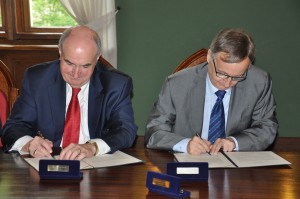
IU President Michael A. McRobbie and Wojciech Nowak, president of Jagiellonian University, renew a partnership agreement between their respective institutions.
Joining the IU delegation here in Krakow on Monday was a prominent figure to many Poles: Lee A. Feinstein, former U.S. ambassador to Poland from 2009 to 2012 and founding dean of the IU School of Global and International Studies. While serving in Poland, Feinstein helmed one of the largest U.S. embassies in the European Union. During his tenure, he signed an agreement to establish a U.S. Aviation Air Force Detachment in Poland, the first permanent U.S. military presence in the country. In October 2012 in Warsaw, President Bronislaw Komorowski awarded him the Commander’s Cross with the Star of the Order of Merit “for his outstanding contributions to Polish-American relations by strengthening cooperation between the Republic of Poland and the United States.”
The stately conference room in which the IU and Jagiellonian officials came together had all the air of a diplomatic meeting, but with little need for any difficult negotiation. IU and Jagiellonian have had a positive and productive relationship dating back more than 30 years and a formal institutional partnership since 1997 involving both faculty and graduate student exchanges. Since 2009, those exchanges have taken place across a wide range of academic disciplines, including music, Slavic languages and literature, and law.
In addition to signing a renewed agreement between their respective institutions, the meeting participants explored a number of potential new collaborative activities toward the goal of expanding faculty and student exchanges. Hannah Buxbaum, wearing dual hats as John E. Schiller Chair in Legal Ethics at the IU Maurer School of Law and academic director of the new IU Europe Gateway office in Berlin, discussed building upon a successful partnership between the Maurer School and Jagiellonian University’s Faculty of Law and Administration, its oldest academic unit. She also talked about how the new gateway office, designed to be a central hub for IU activities across Europe, could help link more IU and Jagiellonian faculty and students.
McRobbie, Feinstein and Vice President for International Affairs David Zaret then took turns speaking about other interesting partnering opportunities, as well as major recent education and research initiatives at IU, such as the establishment of the School of Global and International Studies, a new program in intelligent systems engineering in IU’s School of Informatics and Computing and IU’s Grand Challenges research program. For his part, Feinstein specifically addressed the importance of strengthening IU students’ understanding of Poland’s central relationship with and role in the modern European system.
At almost every turn, the conversation highlighted IU’s long and storied history of engagement in Poland and Eastern Europe. At a time of fundamental political and social transformation in Eastern Europe, IU became actively involved with the study of Poland and helped to establish the American Studies Center in Warsaw and the Polish Studies Center at IU Bloomington in 1976. This led to IU establishing academic programs with Jagiellionian University, as well as with the University of Warsaw, at a time when such formal exchanges between the two countries were rare due to the Cold War.
Maintaining the missions of the modern university
Following the renewal of the agreement between IU and Jagiellonian University, delegation members took part in a brief tour of the university campus and its more-than-650-year-old history. Among the many highlights of the tour were a plaque remembering the almost 200 Jagiellonian faculty members arrested by the Nazis on Nov. 6, 1939 (tragically, many died in the concentration camp); the Drzewo Wolnosci, or “Tree of Freedom,” commemorating Krakow becoming the first city in Poland to be set free after World War I; and a large rectangular room for major ceremonies that featured portraits of all the famous figures in university history, including Pope John Paul II and Copernicus.
Among the places Pope John Paul II and Copernicus both studied was a late-Gothic building known today as the Collegium Maius. One of Jagiellonian University’s oldest buildings, it has been in continuous use for more than 600 years. With a beautiful 15th-century courtyard bordered by arcades, the building — which many years ago housed some of the university’s faculty — currently serves as a museum that reflects the teaching, learning and research missions of today’s best universities.
Within its magnificently decorated walls are thousands of valuable artifacts showcasing the influential role the university has had in developing several major fields of modern academic study. From the time of Copernicus, the museum possesses a fascinating set of three medieval astronomical instruments, including a large celestial globe and an astrolabe, a tool to determine the position of stars and planets that was used for many centuries in astrology, astronomy, surveying, construction and navigation. In the Aula, a room decorated with more than 100 portraits of Polish kings, bishops and outstanding university presidents and professors, resides a stone portal from the former town hall of Krakow that is more than 400 years old.
One especially memorable area of the museum is the Green Room, which displays, among other artifacts, a mid-19th-century French piano and other souvenirs of the renowned Polish composer and virtuoso pianist and Fryderyk Chopin. [Also joining the delegation for part of its time in Krakow was internationally acclaimed Chopin authority Halina Goldberg, a musicologist at the IU Jacobs School of Music.] At one end of the Green Room is a portal, featuring the inscriptions of several dates, including Nov. 6, 1939, reminding visitors of dark times in Polish history. The dates are accompanied by a Latin motto that reads “Ne Cedat Academia” or “May the Academy Persist.”
A meeting with the maestro
From the Collegium Maius, delegation members returned to the main market square for a highly anticipated afternoon meeting with Maestro Krzysztof Penderecki, the eminent Polish composer and conductor, and his wife, Elzbieta, who is an impresario in her own right. She serves as president of the Ludwig van Beethoven Association and general director of the popular Ludwig van Beethoven Easter Festival, which just celebrated its 20th year.
Maestro Penderecki, who studied music at Jagiellonian University and the Academy of Music in Krakow, has been called Poland’s “greatest living composer.” He has composed a number of major works performed by choirs and orchestras all over the world. He has also received several prestigious awards, including the Commander’s Cross in 1964, the Prix Italia in 1967 and 1968, the Knight’s Cross of the Order of Polonia Restituta in 1964, three Grammy Awards in 1987, 1998 and 2001, and the University of Louisville Grawemeyer Award for Music Composition in 1992.
Early next year, IU and its world-renowned Jacobs School of Music will add to Maestro Penderecki’s honors by awarding him with an honorary doctorate in Bloomington. Preparations, led by former Ambassador Feinstein and Jacobs School Dean Gwyn Richards, are already underway for the maestro and Mrs. Penderecki’s forthcoming visit to the Jacobs School.
The distinguished couple couldn’t have been more charming, gracious and accommodating in hosting McRobbie, Feinstein and their fellow IU delegation members. Indeed, the meeting with the maestro provided a particularly fitting coda to a most memorable and inspiring day celebrating the history, education and culture of this exceptional city.
Next stop: Warsaw.
Tags: American Studies Center, Elzbieta Penderecki, Halina Goldberg, Hannah Buxbaum, IU Europe Gateway, IU Jacobs School of Music, IU Maurer School of Law, IU Polish Studies Center, IU School of Global and International Studies, IU School of Informatics and Computing, Jagiellonian University, Krakow, Lee A. Feinstein, Michael A. McRobbie, Poland, University of Warsaw
A blues reunion in Bologna
The IU delegation heard so many incredible stories while helping to celebrate the 50th anniversary of the university’s successful study abroad program in Bologna. But one was especially harmonious.
Janis Russell is an IU alumna who traveled overseas for the first time as a member of the university’s program in Bologna in 1973. While there, she met Michael Brusha, a student at Wisconsin who had been part of the program the year before. Brusha had formed a rhythm and blues band and needed a singer. Russell happily obliged.
Today, Russell is a celebrated jazz and blues singer, who has performed for, among other luminaries, President Bill Clinton, Pope John Paul II and Nelson Mandela. On Friday, she treated the 200 people or so gathered to celebrate 50 years of the IU Bologna Consortial Studies Program to a wonderful tune about her time in Bloomington, Ind., and Bologna. For his part, Brusha has gone on to become a renowned musical figure himself in Bologna — performing live with his band, Born to Swing, and teaching music at the Merry Melodies music school, which he also founded, right around the corner from the Bologna Consortial Studies Program office. IU Associate Vice President for Overseas Study Kathleen Sideli, who manages the program, credits Brusha for bringing a special cultural gift, American music, to Bologna.
Until this weekend, though, Russell and Brusha hadn’t performed together — let alone even seen each other — since their earliest days in his band.
All of this made their long-awaited reunion, which took place at a celebratory luncheon for IU’s Bologna program on a sunny Saturday afternoon, even more special. The performance was also impromptu — Russell didn’t know Brusha had been invited to play.
Take a moment to enjoy Russell and Brusha, and Brusha’s bandmates, deliver a rousing version of the classic R&B song “Route 66.”
Tags: Bologna, IU Bologna Consortial Studies Program, Janis Russell, Michael Brusha, rhythm and blues
Snapshots from Florence and Bologna
It’s been a fantastic four days in Florence and Bologna for Indiana University, beginning with IU and the world-renowned Uffizi Gallery teaming up for an unprecedented initiative to digitize all of the museum’s 1,200 Greek and Roman sculptures, and culminating in the 50th anniversary celebration of one of the university’s most successful study abroad programs.
Along the way in Italy, members of the IU delegation met up with old friends and acquaintances, while also making new inroads into two of Europe’s oldest and most important academic, artistic and cultural centers.
Here are several snapshots from IU’s all-too-brief but highly productive and inspirational time in Italia:
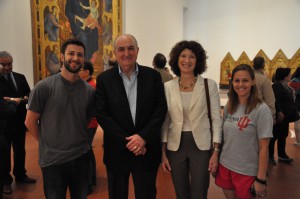
IU truly is everywhere. While previewing the magnificent Uffizi Gallery sculptures and paintings, IU President Michael A. McRobbie and first lady Laurie Burns McRobbie ran into some familiar faces from back home — recent graduates and former Hoosier athletes Matt McKain (soccer) and Gaby Olshemski (field hockey).
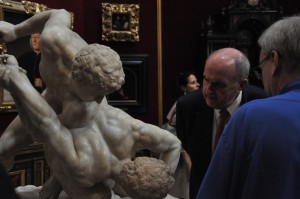
President McRobbie got an up-close look at one of the famous sculptures that IU will digitize in 3-D as part of its landmark agreement with the Uffizi: Lottatori (wrestlers), a first-century B.C. Roman sculpture.
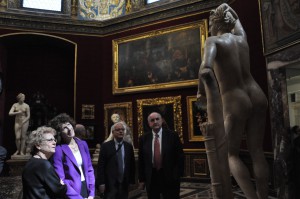
President McRobbie and Bernie Frischer, IU professor of informatics, director of the university’s Virtual World Heritage Laboratory and one of the world’s leading virtual archaeologists, took a special tour of the Uffizi’s most important room, the Tribuna. Digitization work, led by Frischer, will begin this coming week on the sculptures in the room, which houses the famed Medici Venus.
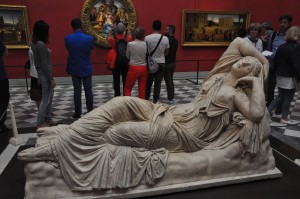
The process to digitize in 3-D all of the Uffizi’s classical sculptures, such as the renowned Arianna dormiente (Sleeping Arianna), will take five years and is expected to be completed — and freely available online — by the time of IU’s bicentennial in 2020.
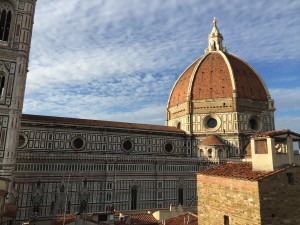
The views in Florence are nothing short of spectacular. Here is a view of the city’s Duomo, taken from atop the roof of the place where students in IU’s overseas study program in Florence live. The popular program is led by IU professor and Hutton Honors College Dean Andrea Ciccarelli, who was a terrific tour guide of the streets and museums of this historic city.

A magnificent fresco painted by the Renaissance master Sandro Botticelli served as the backdrop for the historic announcement between IU and the Uffizi. Beginning in the late 15th century, the fresco, titled “The Annunciation,” hung over the entrance of San Martino della Scala, a hospital situated in the main plaza of nearby Siena for those stricken with the plague.
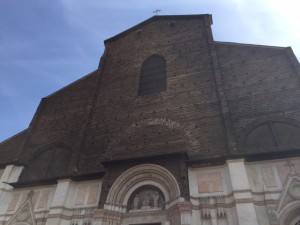
When it was time to move on to Bologna, the IU delegation found a city bursting with history, charm and awe-inspiring ancient structures such as the Basilica of San Petronio, the main church, or Duomo, of Bologna.
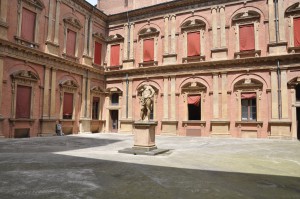
Bologna also boasts the oldest continuously operating university in the Western world, the University of Bologna. Since its earliest days in the late 11th century, the university has built a reputation of international acclaim, attracting such luminaries as Thomas Becket, Erasmus of Rotterdam and Nicolaus Copernicus, among many other famous historical figures who came to the city from all over Europe to study with the university’s prominent scholars.

The Palazzo Poggi Museum at the University of Bologna showcases why the university is often called the “mother of all universities.” Here is a preserved fish, one of many unusual natural specimens from the collection of Ulisse Aldrovandi (1522-1605), the founder of modern natural history.
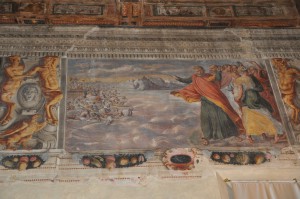
All of the collections in Palazzo Poggi Museum are set against an extraordinary backdrop of 16th-century wall paintings depicting famous events and people in history, such as this one of Moses.
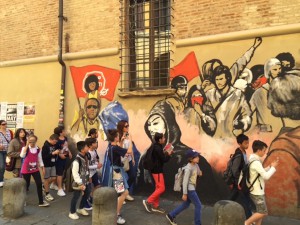
Movements of student protest have been a constant in Bologna, as reflected up and down the campus’s central avenue, Via Zamboni.
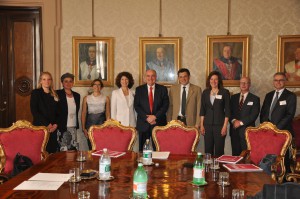
IU was among the first U.S. universities to establish a study abroad program at the University of Bologna. Delegations from both schools met on Friday to praise the program, which is celebrating its 50th anniversary, and explore the possibility of further exchanges of students and faculty.
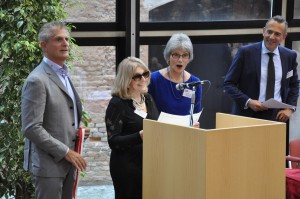
The late IU professor Mark Musa, a renowned Dante scholar, established the bilateral exchange between IU and the University of Bologna, which has since been expanded to a consortium of 15 U.S. colleges and universities managed by IU’s Office of Overseas Study. Here, Musa’s wife, Isabella (pictured at microphone), upon learning that a student scholarship had been established in honor of her husband, surprises everyone by announcing that the celebration of the overseas study program is taking place on her husband’s birthday.
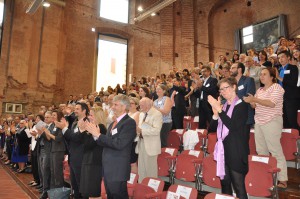
IU delegation members were among the 200 or so people who gathered in Bologna, to celebrate the 50th anniversary of the IU Bologna Consortial Studies Program. The audience included past resident directors, managing directors, consortium representatives and overseas study staff, as well as many of the program’s alumni.
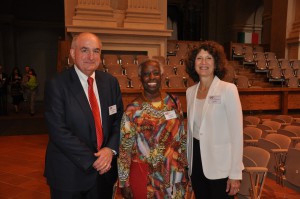
IU President and first lady McRobbie pose for a picture with Janis Russell, an alumnus of both IU and the IU Bologna Consortial Studies Program. Russell has gone on to become an acclaimed jazz and blues singer, who has performed for President Bill Clinton, Pope John Paul II and Nelson Mandela.
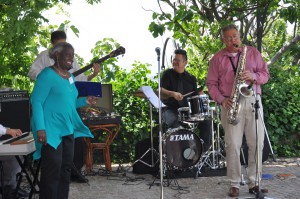
Talk about a reunion! At a celebratory luncheon for the Bologna program on Saturday afternoon, Janis Russell performed a rhythm and blues classic with fellow program alum Michael Brusha. The two hadn’t performed with — let alone even seen — each other since Janis sang in Michael’s band during her year (1973-74) studying in Bologna. Look for some video here soon.
Next stop: Krakow, Poland. Check back soon!
Tags: Bernie Frischer, Bologna, Digital Sculpture Project, Florence, IU Bologna Consortial Studies Program, IU Office of Overseas Study, Janis Russell, Kathleen Sideli, Laurie McRobbie, Mark Musa, Michael A. McRobbie, Palazzo Poggi Museum, Uffizi Gallery, University of Bologna
A big celebration in Bologna
Almost immediately upon setting foot in the narrow, cobbled streets of Bologna, it’s easy to see how the late Indiana University professor and Italian literature scholar Mark Musa would’ve been captivated by this most charming city. It’s also easy to recognize what five decades of IU students — who have studied here as a result of Musa’s vision to connect Bologna to Bloomington, Ind., and create one of IU’s most successful study abroad programs — have come to adore about one of Italy’s most important academic, artistic and cultural centers.
“Bologna è bella!,” the influential Italian poet and teacher Giosuè Carducci declared, and what better way to describe a city that, for centuries, has inspired so many visitors with its magnificent ancient architecture and sculptures, vibrant colors and sensational tastes. [My stomach can vouch: Italian pasta isn’t truly pasta until you’ve visited Bologna.] It is nearly impossible to not stop at every turn and admire a powerful work of art, such as the famous Fontana del Nettuno (Fountain of Neptune) statue in the Quadrilatero, a crossroads of streets bordered by some of the most important monuments and buildings in Bologna. The fantastic fountain stands next to to the dazzling Piazza Maggiore, the city’s central square which includes the magnificent Basilica of San Petronio, also known as the Duomo of Bologna and one of the largest churches in the world.
Here in Bologna is also the oldest continuously operating university in the Western world, the University of Bologna. Since its earliest days in the late 11th century, when masters of grammar, rhetoric and logic began to devote themselves to the study and teaching of law, the university has built a reputation of international acclaim, attracting such luminaries as Thomas Becket, Erasmus of Rotterdam and Nicolaus Copernicus, among many other famous historical figures who came to the city from all over Europe to study with the university’s prominent scholars.
IU was among the first U.S. universities to establish a study abroad program at the University of Bologna. Professor Musa, a renowned Dante scholar, established the bilateral exchange, which has since been expanded to a consortium of 15 U.S. colleges and universities managed by IU’s Office of Overseas Study. Since the first group of students in 1965-66, more than 1,500 alumni have completed the immersive Italian program, and over the past two decades, 280 Italian undergraduate students and dozens of Italian graduate students have come to the U.S. to study at IU and other universities with which IU partners in the consortium. Those students are served by an IU-operated office with a resident program director, Andrea Ricci.
The program has, in the words of IU President Michael A. McRobbie, become one of the “cornerstones of IU’s long and extensive history of international partnership and engagement.”
“The mother of all universities”
On Friday, McRobbie and his fellow IU delegation members had the opportunity to participate in the historic 50th anniversary celebration of this cornerstone, one with a university that, along with other centuries-old European academic institutions, essentially created the modern university as we know it today.
Faculties. Curricula. Conservatories. Examinations. Degrees. All of these now common terms associated with today’s universities were first developed in the old European universities like the University of Bologna, which was founded in 1088.
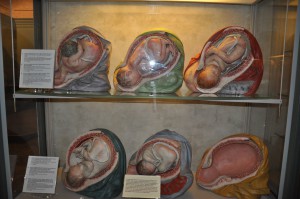
Three-dimensional wax models, featured in the Palazzo Poggi Museum, depict babies developing in the womb.
Indeed, the University of Bologna is frequently called the “mother all of universities” for how it conceived not just the common structure and processes of today’s universities, but also the principles of excellence in education, research and creative activity that these institutions passionately pursue on behalf of their students.
The Palazzo Poggi Museum at the University of Bologna, which McRobbie and several other delegation members toured today, offers a fascinating reflection of the mission of the modern university. The museum painstakingly recreates the laboratories and collections from the old Istituto delle Scienze, which was housed in the rooms of the Palazzo Poggi building from 1711 to 1799. In its time, the Istituto delle Scienze included various laboratories in which cutting-edge research spanned a wide range of fields, including geographical and nautical science, military architecture, experimental physics, natural history, chemistry, anatomy and obstetrics.
The museum, which opened in 2000, has an astonishing array of items in all of these areas — including carefully preserved fish and other unusual natural specimens from the collection of Ulisse Aldrovandi (1522-1605), the founder of modern natural history; three-dimensional wax models depicting babies developing in the womb; and intricate wooden models illustrating the evolution of military fortification systems. All of these collections are set against an extraordinary backdrop of 16th-century wall paintings depicting famous figures and events in history.
In the same Palazzo Poggi building is a younger museum, the Museo Europeo Degli Studenti, which is devoted to the lives of students through the ages. The facility features drawings, sculptures, objects, books, illuminated manuscripts and reconstructions of various environments that enable visitors to explore different aspects and events in the history of student life and gain a greater appreciation for how much the university student has changed — or, in some instances, remained the same — over centuries.
Full-on immersion, a life-altering experience
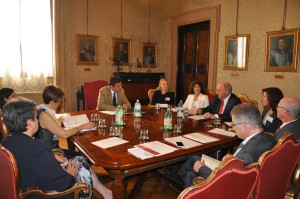
IU delegation members meet with University of Bologna President Francesco Ubertini, seated fourth from left.
The delegation’s museum visits served as a fitting lead-in to a lively mid-afternoon discussion between IU delegation members and current president of the University of Bologna Francesco Ubertini. During the meeting, President McRobbie described IU’s longstanding relationship with Bologna through the Bologna Consortial Studies Program, which offers qualified undergraduate students an opportunity to study for a full academic year or semester at the University of Bologna for U.S. college credit.
He praised the number of graduates from IU who have passed through the program and gone on to distinguished careers in diverse fields around the world. He also discussed IU’s efforts to diversify its student body and provide its graduates with the knowledge and experiences they need to succeed in today’s increasingly connected global marketplace.
To this end, IU Vice President for International Affairs David Zaret and Hannah Buxbaum, academic director of IU’s newly opened gateway office in Berlin, met Friday with University of Bologna faculty in areas in which IU and Bologna have similar strengths to explore new undergraduate and graduate student exchanges and potential collaborations between the two universities’ scholars and researchers.
Presidents McRobbie and Ubertini agreed strongly that these exchanges, in particular study abroad for students, should remain a priority.
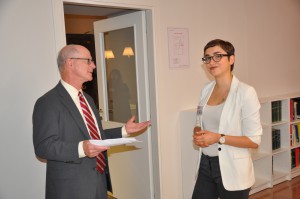
IU Vice President for International Affairs David Zaret chats with IU student Francisca Figueroa, who is participating in the study abroad program in Bologna.
Earlier this morning, members of the delegation had the privilege of spending some time with a number of IU students studying here in Bologna this summer as part of the university-led consortium. Among them was Francisca Figueroa, an Indianapolis native seeking to squeeze every last learning opportunity out of her time studying here in Bologna. Figueroa, a Mexican-American and IU Hudson Holland Scholar, is pursuing multiple majors, including an independent study major in global food sustainability, which has her working with IU Distinguished Professor of Anthropology Richard Wilk, an authority on the history of food globalization. While studying in Bologna this summer, she is also working on a film documentary on the role of the Italian mother in sustainability. And just last year she traveled as a U.S. Student Ambassador to Milan to work at a major international conference centered on the environmental, social and economic complexities of the global food system.
Figueroa’s story, which truly would require several more blog chapters, was just one of the current student testimonials delegation members heard today about the power of a program that fully immerses its young participants in Italian life, learning and culture.
Indeed, all of the program’s students live exclusively with Italian students and enroll directly in University of Bologna courses. Many also perform internships in local museums, schools, law firms, hospitals and other organizations. And their year concludes with oral examinations in Italian — a daunting challenge for most American students.
An anniversary for the ages
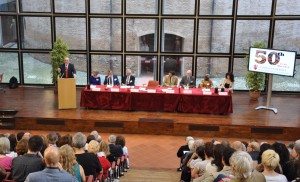
IU President Michael A. McRobbie delivers remarks at the 50th anniversary celebration of the IU Bologna Consortial Studies Program.
Friday afternoon’s joyous 50th anniversary celebration showcased the resounding success of a program that has truly changed the lives of its participants and created lifetime linkages between its many proud alumni.
Indeed, the pride in the air was palpable as Andrea Ricci and Kathleen Sideli, director and managing director of the IU Bologna Consortial Studies Program, respectively, welcomed the past resident directors, managing directors, consortium representatives and overseas study staff who have contributed to a remarkable 50 years of collaboration and greatly enhanced the lives of the program’s alumni, who were also recognized throughout the afternoon.
Many of the former program leaders shared stories with IU delegation members about the many highs and, yes, occasional challenges of a program that has withstood the changes and tumult of the past half century, including the rise of the communist party in the city, the leftist rioting in the 1970s and the tragic bombing, in 1980, of the Bologna train station, which killed 85 people.
The landmark event featured many pleasant surprise moments, as when Mark Musa’s wife, Isabella, upon learning that a student scholarship had been established in honor of her husband, announced that the celebration happened to be taking place on her husband’s birthday.
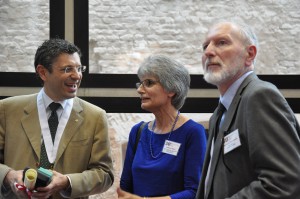
From left: University of Bologna President Francesco Ubertini, Kathleen Sideli, managing director of the Bologna overseas study program and professor Riccardo Giovanelli.
Janis Russell, an IU alumnus and nationally known jazz and blues singer and songwriter, who has performed before President Bill Clinton, Pope John Paul II and Nelson Mandela, later thrilled the 200 or so guests in attendance by breaking into a lilting song about her loving memories of Bloomington and Bologna.
The renowned Italian-born astronomer and professor Riccardo Giovanelli, the first University of Bologna graduate exchange student at IU in 1969-70, also delighted starry-eyed attendees with his humor and remembrances of his time at IU. After graduating from Bologna, Giovanelli entered the graduate program at IU Bloomington as a Fulbright fellow, receiving his Ph.D. in astronomy in 1976. In 1997, he earned the title of Cavaliere della Republica, Italy’s highest ranking honor, by the president of Italy. Currently, he and his wife are on the faculty at Cornell University.
Just a few weeks ago, his name resounded again across the global scientific community, when a team of IU astronomers, who recently found that a small blue galaxy 30 million light-years from Earth could test the Big Bang theory, nicknamed the galaxy “Leoncino” in honor of both its constellation location and in recognition of Giovanelli, who led the group that first identified the galaxy.
Speaking in a soft Italian accent, Giovanelli joked about being the only person on a flight from Indianapolis to Bloomington. (Perfectly deadpan, he added that the flight was “nonstop.”) He then reminisced about what he fondly described as “Bloomington magic,” including playing soccer on Sundays, strolling along the Jordan River and hearing a guitarist play one of his favorite songs, Hoagy Carmichael’s “Stardust,” watching some of the “best basketball ever played” by the 1975-76 championship Hoosiers and meeting his eventual wife, Martha.
“Bloomington will be in my mind for a long, long while,” he said.
Fittingly, the event concluded with McRobbie awarding his University of Bologna counterpart, Ubertini, with IU’s Thomas Hart Benton Mural Medallion, in recognition of the long and successful partnership between their respective institutions.
It was a perfect close to a big day for IU in Bologna, which prominently showcased the power of the university’s partnerships around the world and signaled the promise of even greater global collaboration in the years ahead.
Read more about the 50th anniversary of the IU Bologna Consortial Studies Program, including a detailed history, director and student testimonials, photos and historical documents.
See photos from Friday’s celebration in Bologna.
Tags: Andrea Ricci, BCSP, Bologna, David Zaret, Francesco Ubertini, Francisca Figueroa, Hannah Buxbaum, Istituto delle Science, IU Bologna Consortial Studies Program, IU Europe Gateway, IU Office of Overseas Study, Janis Russell, Kathleen Sideli, Leoncino, Mark Musa, Michael A. McRobbie, Museo Europeo Degli Studenti, Palazzo Poggi Museum, Riccardo Giovanelli, Richard Wilk, Thomas Hart Benton Medallion, University of Bologna
Close connections to Italy and the world
In the span of 24 hours in Florence, members of the IU delegation went straight from engaging with one of Italy’s oldest industries — the creation of magnificent marble sculpture — to experiencing one of the country’s thriving 21st-century forms of business: high-tech manufacturing.
A historic announcement on Wednesday ushered in a new era of collaboration with the world-renowned Uffizi Gallery in Florence. On Thursday, delegation members took time to tour the Italian affiliate of an organization most familiar to those back home in Indiana and one with a longstanding and productive relationship with IU: Eli Lilly.
Eli Lilly Italy is headquartered in the Sesto Fiorentino area of Florence, which is only about a 30-minute drive from the Uffizi, the famed Florence cathedral (Il Duomo di Firenze) and other main sights of the city. Now more than 50 years old, it is home to one of Italy’s largest sites for the production of pharmaceutical medicines, with about 1,100 employees who work in a state-of-the-art, 43,000-square-foot office and manufacturing facility neatly ensconced beneath the beautiful rolling hills of Tuscany. Recently, the Great Place to Work Institute ranked Lilly Italy in the top 10 of the best working environments in the world.
Lilly’s Sesto manufacturing plant, which represents around 2.5 percent of Lilly’s overall global revenue, is one of the largest facilities for biotech products in Italy and the only site in the country to produce insulin. For more than a dozen years now, the plant’s primary mission has been to provide insulin products, including cartridges and pre-filled devices of human insulin and insulin analogues, to more than 50 markets around the world.
Among its core products is Humalog, a designer insulin discovered by IU Distinguished Professor Richard DiMarchi, a highly respected international authority in the discovery, development and manufacture of new drugs who spent 22 years as a senior research scientist at Eli Lilly.
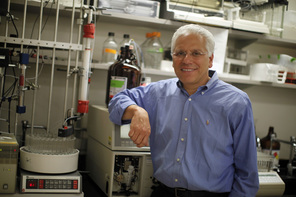
IU Distinguished Professor Richard DiMarchi spent 22 years as a senior research scientist at Eli Lilly, where he founded Humalog, a designer insulin.
The DiMarchi connection is just one of many links in the long legacy of collaboration and cooperation between IU and Lilly. The current chair of the IU Board of Trustees, Randy Tobias, is Lilly’s former chairman and CEO. Another trustee, Derica Rice, currently serves as the company’s executive vice president for global services and CFO.
Over several decades, many IU grads have gone to work for Lilly, and strong academic connections have been made between Lilly and IU’s School of Medicine as well as its Department of Medicine.
IU’s relationship with Lilly has extended into other key areas as well. The Lilly Endowment, one of the world’s largest private philanthropic foundations, has been extraordinarily generous to IU and other universities around Indiana, providing them with millions of dollars of funding for educational, entrepreneurship and research initiatives. The Lilly Foundation has also supported IU’s efforts to strengthen higher education around the state. And not to be forgotten, of course, is the IU Lilly Family School of Philanthropy, founded in 2012 and globally recognized as the first of its kind. The school’s mission is to increase the understanding of philanthropy and improve its practice worldwide.
If today’s introductory meeting offered any indication, the bond between IU and Lilly, specifically with regard to their global efforts, is likely to only get stronger in subsequent years. With its active undergraduate exchange partnerships around the world, including several that delegation members will celebrate in the next few days, IU aims to provide its students with a globalized curriculum and the type of practical experience, including internships with foreign companies, they need to succeed in the international marketplace. In turn, Lilly Italy is seeking to find ways to enhance the competencies of its workforce and find partners, including colleges and universities foreign and domestic, who can help the company respond to the pharmaceutical industry’s ever-evolving needs.
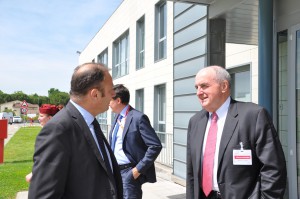
IU President Michael A. McRobbie, right, meets with Eric Ballet, president and general manager of Lilly Italy.
Delegation members wrapped up their time at Lilly Italy with a tour of the manufacturing plant, where they were given a first-hand look at how the company works to isolate, produce, sterilize and package its insulin products. An intricate and complex process, it relies on the efficient and effective combination of highly skilled manpower and new technology, a combination that has been so successful here in Sesto Fiorentino that Lilly will seek to replicate it in Indianapolis, as well as in France and China.
Indeed, there was much to admire and appreciate about Lilly’s Italian headquarters on a day that offered compelling evidence of the power of global engagement and IU’s closeness to Italy, Europe and the world.
Next stop: Bologna.
Tags: Eli Lilly Italy, Florence, Italy, IU Department of Medicine, IU School of Medicine, Lilly, Lilly Endowment, Lilly Family School of Philanthropy, Lilly Foundation, Lilly Italy, Michael A. McRobbie, pharmaceutical industry, Uffizi Gallery
A historic, inventive and inspiring collaboration
Call it the birth of a genuine Renaissance partnership.
Today marked the beginning of Indiana University’s weeklong trip to Italy and Poland, and one couldn’t have scripted a more momentous and inspiring way to inaugurate what promises to be a historic next few days in several of Europe’s oldest cities.
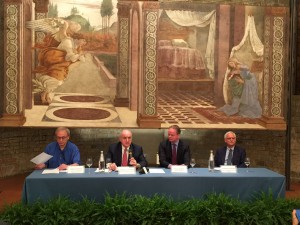
Indiana University President Michael A. McRobbie, second from left, announces a new partnership between IU and the Uffizi Gallery in Florence, Italy, which calls for IU to digitize, in 3-D, the museum’s entire collection of Greek and Roman sculpture.
Early this morning, under an already bright Tuscan sun, members of the IU delegation, led by President Michael A. McRobbie, traveled to the historic Uffizi Gallery in central Florence, Italy, one of the oldest and most renowned art museums in the world. Home to some of the finest masterworks of the Renaissance period in Europe, the Uffizi showcases works by, among others, Botticelli, Caravaggio, da Vinci, Fra Angelico, Michelangelo, Raphael and Titian. More than 1.5 million visitors pass through the museum’s galleries each year, making it the most visited museum in Italy.
The Uffizi collection contains 1,250 pieces of irreplaceable Greek and Roman sculpture, which are located at the gallery as well as the Pitti Palace and Boboli Gardens, two other famous cultural sites in Florence. The 1,250 works of art comprise the third largest collection of its kind in an Italian state museum. Largely assembled by the Medici family from the 15th to the 18th centuries, the sculptures include some of the most admired classical antiquities in the history of art, notably the Medici Venus, the Medici Faun, the Niobids and the Ariadne. Many of the Uffizi’s marble sculptures adorn the magnificent long corridors that outline the U-shaped second floor of the museum.
Just as they did during the time of the Renaissance, these ancient statues continue to attract the attention of all kinds of artists, including poets, painters and sculptors, who are able to find inspiration in their reflection of beauty, balance, harmony and superior craftsmanship.
Rebirth and recreation
Around midday today, the sculptures were the subject of a different type of attention, however, as members of the IU delegation were led to a most auspicious setting within the Uffizi complex to make a historic announcement: the former Church of San Pier Scheraggio.
Known as the “vanished church,” it was constructed in the eighth century on top of the remains of a second-century Roman temple. A Romanesque church was dedicated in 1068, and it began serving a central role in Florentine society, used not only for religious services but also city council meetings. In the main body of the church, during several important assemblies, the legendary Italian poets and scholars Dante, Boccaccio and Petrarca delivered orations to the people of Florence.
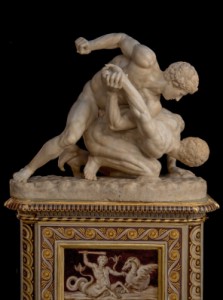
Lottatori, (wrestlers), first century B.C. Roman sculpture, is part of the Uffizi Gallery collection in Florence, Italy, to be digitized in 3-D.
Today, the remains of the church are on via della Ninna (the “lullaby” street), a small and shaded avenue that lies between the Palazzo Vecchio and the Uffizi Palace. Within the church, which is now considered one of the Uffizi Gallery exhibition rooms, there are several sculptures and paintings, including a triad of mural paintings honoring Dante, Boccaccio and Petrarca. But the crown jewel of the room is a fresco painted by the Renaissance master Sandro Botticelli. Beginning in the late 15th century, the fresco, titled “The Annunciation,” originally hung over the entrance of San Martino della Scala, a hospital situated in the main plaza of nearby Siena for those stricken with the plague.
Fittingly in this place of continual rebirth and recreation, and surrounded by the most famous figures of Florentine history, IU and the Uffizi jointly announced a historic collaboration that calls for the digitization, in 3-D, of the museum’s entire collection of ancient sculpture. The project between the Uffizi and IU’s Virtual World Heritage Laboratory will result in the creation of high-resolution 3-D digital models of the Uffizi sculptures, which will also be made freely available online by IU’s bicentennial in 2020.
The announcement of the digitization project was jointly made by McRobbie and Uffizi Director Eike Schmidt, who signed an agreement to carry out this unprecedented initiative. In his remarks at the announcement, McRobbie described the IU-Uffizi collaboration as “a historic and hugely ambitious project, one that will generate unparalleled opportunities for scholarly engagement with one of the greatest cultural institutions in the world and its legendary collections.
“Indeed, it would be nearly impossible to overstate the cultural and educational impact of this extraordinary and inventive collaboration,” he added. “IU’s scholarly expertise in ancient art and culture, as well as our technological expertise, will be leveraged to bring to virtual light a collection of classical antiquities that has inspired some of the greatest artistic geniuses in the history of Western art.”
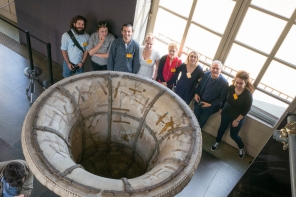
A team from Indiana University and Milan Politechnic gather around a large Medicean vase being scanned to create a 3-D model. Second from right is Bernard Frischer, IU professor of informatics and director of the university’s Virtual World Heritage Laboratory.
The IU-Uffizi collaboration will be led by Bernie Frischer, IU professor of informatics, director of the university’s Virtual World Heritage Laboratory and one of the world’s leading virtual archaeologists. Frischer, who also spoke at today’s announcement, was one of the first academics to use 3-D computer modeling to reconstruct cultural heritage sites, and he has overseen a number of major modeling projects, most notably Rome Reborn, a virtual re-creation of the entire city of ancient Rome within the Aurelian Walls. In recent years, he has focused on digitization and digital restoration of ancient sculpture, as well as a 3-D restoration model of Hadrian’s Villa, one of the Roman Empire’s best-known and best-preserved imperial villas.
The five-year project between IU and the Uffizi will also include training IU informatics and art history students in the techniques of 3-D data capture, digital modeling and interactive online publication; creating a limited number of 3-D restoration models of works of sculpture of interest to individual project participants; and publishing the 3-D models on several online sites, including the Italian Ministry of Culture’s internal conservation database, the Uffizi’s public website and the Virtual World Heritage Laboratory’s publicly available Digital Sculpture Project.
A further goal of the project will be to launch a new collaborative relationship between the Uffizi and IU’s newly named Sidney and Lois Eskenazi Museum of Art that could include mutual loans of works of art, the development of temporary joint exhibitions and the creation of new virtual gallery tours. Indeed, plans are already underway for the first such project: the creation of a virtual-reality experience of the Tribuna, one of the Uffizi’s most important galleries.
The IU Mark Cuban Center for Sports Media and Technology, housed in IU Athletics, will collaborate on the Tribuna project, which is expected to be the first of a series of exhibitions at the Eskenazi Museum of Art using virtual reality technology.
As if the day hadn’t been memorable enough, following the announcement, members of the delegation received a special tour of the Tribuna room and its extraordinary contents, including the famed Venus de’ Medici sculpture and the Roman marble sculpture known as The Wrestlers. [The 3-D digitization work on the sculptures in the Tribuna will begin next week.]
Here, in the heart of the Uffizi, it was truly an honor and a privilege to experience these extraordinary works of art up close and personal. And even though we could’ve spent several more hours walking the halls of the Uffizi, all of us could look forward to the exciting possibilities of a truly historic, inventive and inspiring collaboration.
Related links:
Explore a 3-D image of Priestess, late first or early second century AD, in white marble
Explore a 3-D image of Tiberius, circa 14 AD, in Parian marble.
Tags: Bernie Frischer, Digital Sculpture Project, Eike Schmidt, Florence, Italy, IU Eskenazi Art Museum, Mark Cuban Center for Sports Media and Technology, Michael A. McRobbie, Uffizi Gallery, Virtual World Heritage Laboratory
Historic anniversaries, new global connections in Italy and Poland
Beginning May 25, an Indiana University delegation led by IU President Michael A. McRobbie will embark on a weeklong trip to Italy and Poland, where the university will celebrate prominent anniversaries with key institutional partners dating back as much as a half century while also pursuing new connections that will strengthen IU’s longstanding ties to Europe.
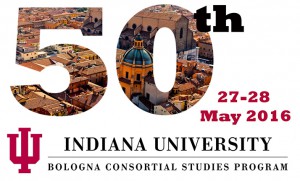
Members of an IU delegation to Italy and Poland will celebrate several key milestones, including the 50th anniversary of IU’s study abroad program at the University of Bologna in Italy.
While in the two countries, McRobbie, Vice President for International Affairs David Zaret and other delegation members will celebrate two major milestones in the university’s storied history of international engagement: the 50th anniversary of IU’s popular study abroad program in Bologna, Italy, and the 40th anniversary of its successful partnership with the University of Warsaw in Poland.
During the week, McRobbie and Zaret will also meet in Florence with representatives of the Uffizi Gallery Museum, one of the world’s most renowned art museums, and visit Eli Lilly and Co.’s Italian headquarters. In Poland, they will renew IU’s agreement with the University of Warsaw and also reinforce IU’s relationship with Jagiellonian University, one of the country’s oldest and most influential institutions of higher education. The group will also tour the POLIN Museum of the History of Polish Jews with an IU alumnus who directs its core exhibition, meet with top governmental and education leaders, and visit with engaged alumni.
For many decades now, Italy and Poland have been central to IU’s global mission. That mission, as outlined in the university’s Bicentennial Strategic Plan, calls for IU to cement its position as one of the world’s pre-eminent global universities by increasing study abroad opportunities for its students, recruiting talented foreign scholars to its campuses and strengthening its connections with the university’s many international alumni living and working around the world. These efforts are all part of IU’s ever-expanding Global Gateway Network, which now includes offices in Beijing, New Delhi and Berlin.
IU’s expansion of long-held partnerships in Italy and Poland reflects the university’s legacy of global engagement that is intended — in the words of the university’s legendary 11th president, Herman B Wells — to bring Indiana to the world and the world to Indiana.
IU was among the first U.S. universities to establish a study abroad program at the University of Bologna, the oldest university in the Western world, established in 1088. Mark Musa, a renowned Dante scholar and IU professor, established a bilateral exchange which has since been expanded to a consortium of 15 U.S. colleges and universities managed by IU’s Office of Overseas Study. Since the first group in 1965-66, more than 1,500 alumni have completed the immersive Italian program and over 300 University of Bologna students have studied in the U.S.
Likewise, at a time of dramatic political and social transformation, IU became actively involved with the study of Poland. In 1976, IU helped to establish the American Studies Center in Warsaw, the first such center in Eastern Europe, and the Polish Studies Center, housed at IU Bloomington. This led to IU developing academic programs with the University of Warsaw and Jagiellonian University during the Cold War, when such formal exchanges between the two countries was uncommon.
I’ll serve as your eyes and ears to IU’s time in Italy and Poland, delivering first-hand, real-time reports of many of the delegation’s daily activities, sharing information about our historic ties to Europe and offering insights into IU’s ongoing effort to strengthen its international engagement efforts.
I hope you will follow along and check in frequently as I share news, photos and updates, and please feel free to reach out to me directly with questions at rpiurek@iu.edu.
Tags: Bologna, David Zaret, Eli Lilly and Co., Florence, Indiana Alumni Association, Italy, IU Europe Gateway, IU Global Gateway Network, IU Office of Overseas Study, IU study abroad, Jagiellonian University, Krakow, Michael A. McRobbie, Poland, POLIN Museum of the History of Polish Jews, Uffizi Gallery, University of Bologna, University of Warsaw, Warsaw

